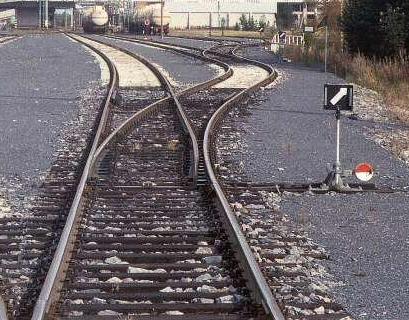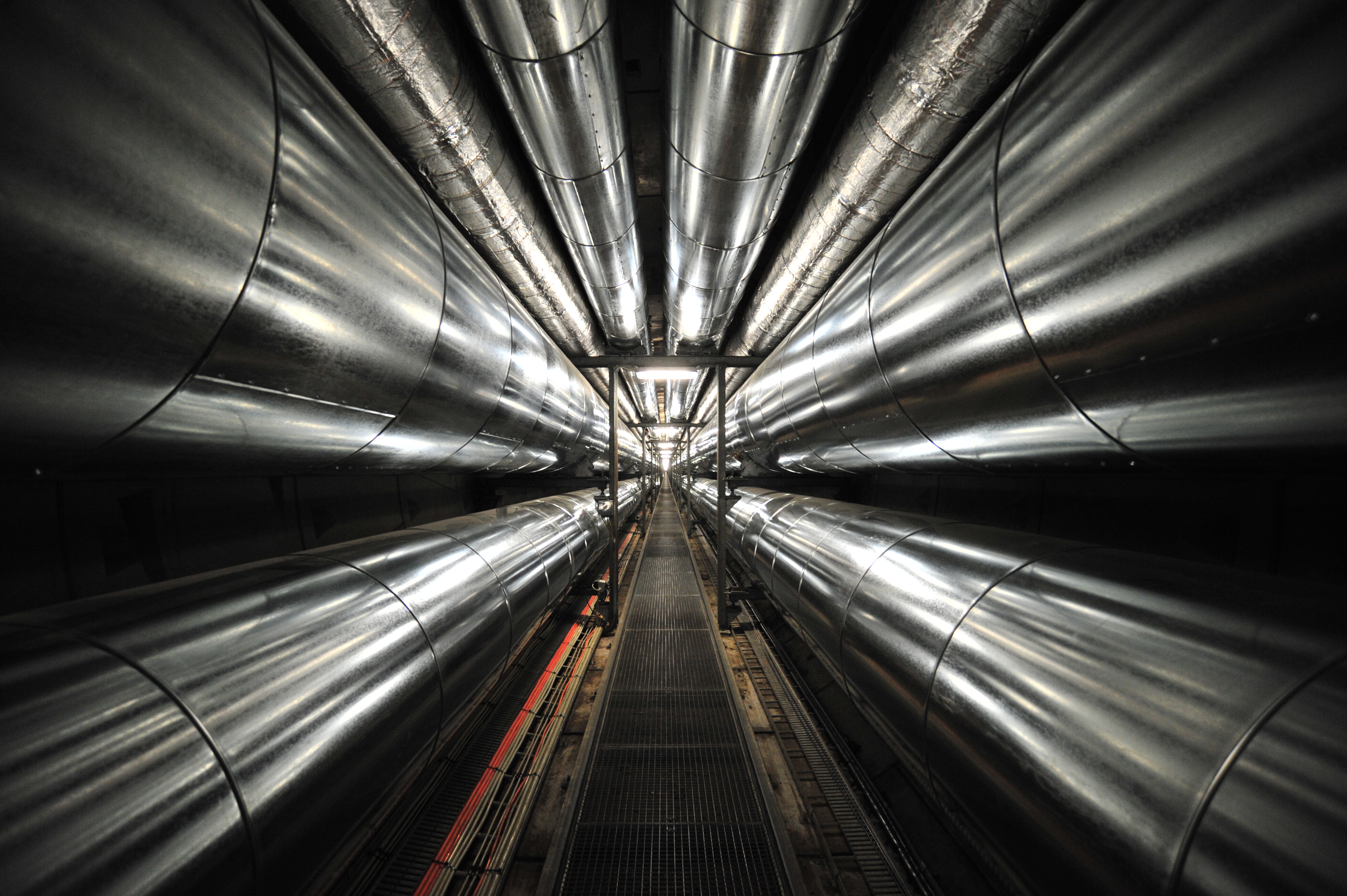|
Guard Rail (rail)
In rail transport, guard rails or check rails are rails used in the construction of the track, placed parallel to regular running rail to keep the wheels of rolling stock in alignment to prevent (or at least reduce the severity of) derailment. They are generally used along areas of restricted clearance, such as a bridge, trestle, tunnel, or level crossing. They also help to minimize damage to the structure and allow easier post-accident cleanup. History Although guard rails in some form have been used as long as there have been trains, the precursor of the guard rails in use today was detailed in , filed in 1893 by Gorham B. Ames, based in Laconia, New Hampshire, US. Applications Bridges Guard rails are an essential component of railroad bridges. Their presence prevents a derailed train from striking and damaging bridge components, or deviating from the track enough to leave the tracks entirely and roll over or fall. Sharp curves On sharp curves, guard rails m ... [...More Info...] [...Related Items...] OR: [Wikipedia] [Google] [Baidu] |
Railway Track At Dieu Tri
Rail transport (also known as train transport) is a means of transport using wheeled vehicles running in railway track, tracks, which usually consist of two parallel steel railway track, rails. Rail transport is one of the two primary means of land transport, next to road transport. It is used for about 8% of passenger and rail freight transport, freight transport globally, thanks to its Energy efficiency in transport, energy efficiency and potentially high-speed rail, high speed.Rolling stock on rails generally encounters lower friction, frictional resistance than rubber-tyred road vehicles, allowing rail cars to be coupled into longer trains. Power is usually provided by Diesel locomotive, diesel or Electric locomotive, electric locomotives. While railway transport is capital intensity, capital-intensive and less flexible than road transport, it can carry heavy loads of passengers and cargo with greater energy efficiency and safety. Precursors of railways driven by human or an ... [...More Info...] [...Related Items...] OR: [Wikipedia] [Google] [Baidu] |
Level Crossing
A level crossing is an intersection where a railway line crosses a road, Trail, path, or (in rare situations) airport runway, at the same level, as opposed to the railway line or the road etc. crossing over or under using an Overpass#Railway, overpass or tunnel. The term also applies when a light rail line with separate Right-of-way (railroad), right-of-way or reserved track crosses a road in the same fashion. Other names include railway level crossing, railway crossing (chiefly international), grade crossing or railroad crossing (chiefly American), road through railroad, criss-cross, train crossing, and RXR (abbreviated). There are more than 100,000 level crossings in Europe and more than 200,000 in North America. Road-grade crossings are considered incompatible with high-speed rail and are virtually non-existent in European high-speed train operations. File:The 5.20 for West Kirby leaving Hoylake - geograph.org.uk - 1503619.jpg, A level crossing at Hoylake, Merseyside, Engl ... [...More Info...] [...Related Items...] OR: [Wikipedia] [Google] [Baidu] |
Guide Rail
A guide rail is a device or mechanism to direct products, vehicles or other objects through a channel, conveyor, roadway or rail system. Several types of guide rails exist and may be associated with: * Factory or production line conveyors * Power tools, such as table saws * Elevator or lift shafts * Roadways and bridges (in this context sometimes called Guard rails (railroad), guardrails) * A central rail that guides the rubber tired train of a Rubber-tyred metro#Technology, rubber tired metro Factory guide rail Most factories use guide rails convey products and component parts along an assembly line. This conveyor system propels products of various sizes, shapes, and dimensions through the factory over the course of their assembly. Power tool guide rail Accessory to a power tool, such as a straight, swivel or angle jig for a circular saw, and can also be referred to as a fence. The guide rail system provides an acute method of cutting material. Elevator shaft guide rail Gu ... [...More Info...] [...Related Items...] OR: [Wikipedia] [Google] [Baidu] |
Guide Bar
Guide bars, or guiding bars are rubber-tyred metro systems that incorporate track. They have angle irons as outside of the two roll ways. The Busan Subway Line 4 lacks a rail track, and has I-beams installed as guide bars. The flanges are vertical. The Sapporo Municipal Subway, that lacks a rail track as well, has no guide bars. It has a central guide rail instead. Guide bars are also used to provide guidance for guided buses. Gallery See also * Automated guideway transit * Bracket * chainsaw * Flangeways * Fourth rail * Guide rail * Overhead conductor rail * Rail profile * Roll way * Rail track * The technology of rubber-tyred metros * Third rail A third rail, also known as a live rail, electric rail or conductor rail, is a method of providing electric power to a railway locomotive or train, through a semi-continuous rigid conductor placed alongside or between the rails of a track (r ... References External links Visual dictionary* ... [...More Info...] [...Related Items...] OR: [Wikipedia] [Google] [Baidu] |
Railroad Switch
A railroad switch (American English, AE), turnout, or (set of) points (Commonwealth English, CE) is a mechanical installation enabling railway trains to be guided from one Rail tracks, track to another, such as at a Junction (rail), railway junction or where a Branch line, spur or Siding (rail), siding branches off. Design The parts of a turnout are known by different names in different jurisdictions. The main terms in U.S. and UK usage are shown in the selectable diagrams. In this article, the U.S. term is listed first and UK second, in parentheses. The most common type of switch consists of a pair of linked tapering rails, known as ''points'' (''switch rails'' or ''point blades''), lying between the diverging outer rails (the ''stock rails''). These points can be moved laterally into one of two positions to direct a train coming from the point blades toward the straight path or the diverging path. A train moving from the narrow end toward the point blades (i.e. it ... [...More Info...] [...Related Items...] OR: [Wikipedia] [Google] [Baidu] |
The Argus (Melbourne)
''The Argus'' was an Australian daily morning newspaper in Melbourne from 2 June 1846 to 19 January 1957, and was considered to be the general Australian newspaper of record for this period. Widely known as a conservative newspaper for most of its history, it adopted a left-leaning approach from 1949. ''The Argus''s main competitor was David Syme's more liberal-minded newspaper, ''The Age ''The Age'' is a daily newspaper in Melbourne, Australia, that has been published since 1854. Owned and published by Nine Entertainment, ''The Age'' primarily serves Victoria (Australia), Victoria, but copies also sell in Tasmania, the Austral ...''. History The newspaper was originally owned by William Kerr, who was also Melbourne's town clerk from 1851 to 1856 and had been a journalist at the '' Sydney Gazette'' before moving to Melbourne in 1839 to work on John Fawkner's newspaper, the ''Port Phillip Patriot''. The first edition was published on 2 June 1846. The paper soon became k ... [...More Info...] [...Related Items...] OR: [Wikipedia] [Google] [Baidu] |
Shepherdstown Railroad Bridge WV2
{{Geodis ...
Shepherdstown is the name of some places in the United States of America: * Shepherdstown, Ohio, in Wheeling Township, Belmont County *Shepherdstown, Pennsylvania *Shepherdstown, West Virginia Shepherdstown is a town in Jefferson County, West Virginia, United States, located in the lower Shenandoah Valley along the Potomac River. Home to Shepherd University, the town's population was 1,531 at the time of the 2020 census. The town wa ... [...More Info...] [...Related Items...] OR: [Wikipedia] [Google] [Baidu] |
Laconia, New Hampshire
Laconia ( ) is a city in Belknap County, New Hampshire, United States. The population was 16,871 at the 2020 census, up from 15,951 at the 2010 census. It is the county seat of Belknap County. Laconia, situated between Lake Winnipesaukee and Lake Winnisquam, includes the villages of Lakeport and Weirs Beach. Each June, the city hosts Laconia Motorcycle Week, also known as "Bike Week," one of the country's largest motorcycle rallies. Name Laconia is named after the Greek region of Laconia (Greek: Λακωνία, ''Lakonía'', Greek pronunciation: akoˈni.a in the southeastern part of the Peloponnese peninsula. History A large Abenaki Indian settlement called Aquadoctan once existed at the point now known as The Weirs, named by colonists for fishing weirs discovered at the outlet of the Winnipesaukee River. Early explorers had hoped to follow the Piscataqua River north to Lake Champlain in search of the great lakes and rivers of Canada mentioned in Indian folklore ... [...More Info...] [...Related Items...] OR: [Wikipedia] [Google] [Baidu] |
Tunnel
A tunnel is an underground or undersea passageway. It is dug through surrounding soil, earth or rock, or laid under water, and is usually completely enclosed except for the two portals common at each end, though there may be access and ventilation openings at various points along the length. A pipeline differs significantly from a tunnel, though some recent tunnels have used immersed tube construction techniques rather than traditional tunnel boring methods. A tunnel may be for foot or vehicular road traffic, for rail traffic, or for a canal. The central portions of a rapid transit network are usually in the tunnel. Some tunnels are used as sewers or aqueducts to supply water for consumption or for hydroelectric stations. Utility tunnels are used for routing steam, chilled water, electrical power or telecommunication cables, as well as connecting buildings for convenient passage of people and equipment.Salazar, Waneta. ''Tunnels in Civil Engineering''. Delhi, India : Wh ... [...More Info...] [...Related Items...] OR: [Wikipedia] [Google] [Baidu] |
Pekon Rail Track With Guard Rail
Pekon (, also spelt Pekhon, Phekhon) is a town in far southern Shan State, eastern Myanmar on the shores of the Mobye Reservoir near the border with Kayah State. It is the seat of the Pekon Township in the Kalaw District. It is divided into 7 wards. Demographics In 2018, the town had 15,351 people and decreased slightly to 15,323 people by 2019. Most of the town is inhabited by children, with over 65.4% of the town being under the age of 18 as of 2019. Pekon is primarily inhabited by the Kayan people, a subgroup of the Karenni people. The Kayan reclassified themselves into two further subgroups in 2005 with the Latha people living in Pekon. The town is also the namesake for the standard dialect of the Kayan language- better known as the Padaung language. Pekon Kayan, spoken by the Latha, is not mutually intelligible with the Kayan spoken further into the hills by other Kayan peoples. History Pekon is home to the military base for Military Operations Command No. 2 and No. 7. The ... [...More Info...] [...Related Items...] OR: [Wikipedia] [Google] [Baidu] |
Trestle Bridge
A trestle bridge is a bridge composed of a number of short spans supported by closely spaced frames usually carrying a railroad line. A trestle (sometimes tressel) is a rigid frame used as a support, historically a tripod used to support a stool or a pair of isosceles triangles joined at their apices by a plank or beam such as the support structure for a trestle table. Each supporting frame is a bent. A trestle differs from a viaduct in that viaducts have towers that support much longer spans and typically have a higher elevation. Timber and iron trestles (i.e. bridges) were extensively used in the 19th century, the former making up from 1 to 3 percent of the total length of the average railroad. In the 21st century, steel and sometimes concrete trestles are commonly used to bridge particularly deep valleys, while timber trestles remain common in certain areas. Many timber trestles were built in the 19th and early 20th centuries with the expectation that they would be te ... [...More Info...] [...Related Items...] OR: [Wikipedia] [Google] [Baidu] |




